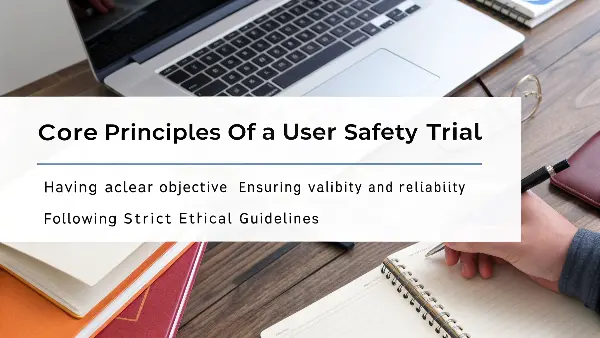Launching a new adult product is exciting, but what if it leads to discomfort or harm? Negative reviews, costly returns, and damage to your brand’s reputation can follow. A well-designed user safety trial is your best defense, catching potential issues before they ever reach your customers.
A user safety trial is a structured process to test a new adult product with a small, select group of real users before mass production. The primary goal is to identify any potential safety issues, comfort problems, or design flaws. This involves setting clear objectives, carefully selecting participants, systematically collecting data, and maintaining strict ethical oversight to ensure the final product is safe and enjoyable for your market.

As a manufacturer, I’ve seen the difference a good safety trial makes. It’s not just about ticking a box; it’s about upholding your commitment to your customers. A thoughtfully designed trial transforms a product from a prototype into a trusted, market-ready item. It provides the concrete data you need to move forward with confidence, knowing you have minimized risks and maximized user satisfaction. This post will walk you through the key steps to designing a trial that truly protects both your customers and your brand.
What Are the Core Principles of a User Safety Trial?
You’re ready to run a safety trial, but the process seems overwhelming. A poorly planned trial is a waste of time and money, and worse, it can miss critical safety flaws, giving you a false sense of security. How can you be sure your trial is built on a solid foundation?
The core principles of an effective user safety trial are having a clear objective, ensuring the trial is valid and reliable, and following strict ethical guidelines. This means you must define exactly what you’re testing for, design the study to produce accurate and consistent results, and prioritize the well-being, privacy, and informed consent of every single participant.

Building a safety trial from the ground up requires a methodical approach. It’s not about just handing out products and hoping for the best. Over the years, I’ve learned that success hinges on getting the fundamentals right before you even think about recruiting a single person. These principles are the bedrock of any successful trial.
Key Foundational Principles
A successful user safety trial is built on three pillars: a clear objective, methodological rigor (validity and reliability), and uncompromising ethics.
-
Clear Objectives: You must start by asking, "What exactly are we trying to find out?" Your objective shouldn’t be vague like "see if the product is safe." It needs to be specific. For example: "To identify any instances of skin irritation from the silicone after 30 minutes of continuous use," or "To determine if the product’s shape causes any physical discomfort or pinching during typical use scenarios." Defining these specifics focuses your entire trial, from participant selection to the questions you ask in your feedback forms.
-
Validity and Reliability: These two terms are crucial.
- Validity means your trial actually measures what it claims to measure. If you’re testing for ergonomic comfort, your questions must be about hand-feel, grip, and reach—not about the color or packaging.
- Reliability means that if you ran the test again under the same conditions, you would get similar results. This is achieved through standardization. Every participant should receive the same product, the same instructions, and the same questionnaire. This consistency prevents random variables from skewing your data.
-
Ethical Conduct: This is the most important principle. You are dealing with real people and a sensitive product category. You must obtain informed consent, which means participants know exactly what the trial involves, what the risks are, and that they can withdraw at any time without penalty. Confidentiality is non-negotiable. All data must be anonymized to protect participant privacy.
By establishing these core principles at the outset, you create a framework that ensures your trial is not only effective but also responsible.
How Should You Recruit and Select Participants for a Safety Trial?
You need people to test your new product, but finding the right individuals seems impossible. If you recruit the wrong demographic, your safety data will be skewed and unreliable, potentially missing issues that will affect your actual target customers. How do you find the right people and screen them effectively?
Recruiting for a safety trial involves creating a detailed participant profile based on your target market, then using focused channels like private email lists or specialized agencies to find candidates. The selection process must include a comprehensive screening questionnaire to weed out unsuitable applicants and ensure your final group accurately represents your future customers, all while maintaining strict confidentiality.

Finding the right participants is part art, part science. I remember for one of our early products, we had to restart recruitment because our initial pool was too narrow. They were all experienced toy users, and they completely missed an ergonomic issue that a novice user would spot immediately. That lesson taught me that the "who" of your trial is just as important as the "what." A well-chosen group of testers gives you insights that are directly applicable to the real world, saving you from costly post-launch surprises.
A Step-by-Step Guide to Recruitment and Selection
Getting the right people in your trial is critical for generating meaningful data. A flawed participant pool leads to flawed conclusions. Here’s a structured approach to ensure you get it right.
1. Define Your Ideal Participant Persona
Before you write a single recruitment ad, you need to know who you’re looking for. This persona should mirror your target customer. Ask yourself:
- Demographics: What is the target age range, gender identity, and location?
- Experience Level: Are you targeting beginners or experienced adult toy users? This will heavily influence feedback on usability and features.
- Specific Needs or Sensitivities: Are you testing a product for people with specific physical conditions (e.g., arthritis affecting grip) or skin sensitivities?
Create a clear profile. For example: "Females aged 30-45, located in the USA, who have purchased at least one vibrator in the past two years but consider themselves intermediate users."
2. Choose Your Recruitment Channels
Where do you find these people? Avoid broad, public calls on social media, as they attract professional testers and people who aren’t serious. Better options include:
- Existing Customer Email Lists: Your most loyal customers are often happy to help. Ensure you have their permission for such communications.
- Third-Party Research Panels: Companies specialize in recruiting vetted participants for sensitive studies. They handle a lot of the screening and logistics for you.
- Private Online Communities: Find relevant, well-moderated forums or groups where your target audience congregates. Always respect the community’s rules about recruitment.
3. Develop a Comprehensive Screening Questionnaire
This is your gatekeeper. A good screener filters out unqualified candidates and ensures you get a balanced group. It should be an online form designed to be quick but thorough.
| Section | Key Questions to Include |
|---|---|
| Demographics | Age, Gender Identity, Location. These help you match your target persona. |
| Experience Level | "How many adult toys have you used in the past five years?" (e.g., 0, 1-2, 3-5, 5+). "How would you rate your comfort level with using new adult products?" (Beginner, Intermediate, Advanced). |
| Health & Allergies | "Do you have any known allergies to materials like silicone, ABS plastic, or latex?" "Do you have any medical conditions that might affect your ability to use this type of product safely?" (This must be worded carefully for privacy). |
| Consent & Availability | "Do you understand that this trial involves testing a new adult product?" "Are you available to follow the trial protocol and provide feedback over the next [X] weeks?" "Do you consent to our privacy policy regarding the handling of your data?" (Include a link to the policy). |
After screening, select a group that reflects the diversity within your target persona. Don’t just pick the most enthusiastic people; aim for a representative sample.
What Key Data Should You Collect During a Safety Trial?
Your participants are ready, but what information should you actually be gathering? If you only ask vague questions like "Did you like it?", you’ll get useless feedback. You need specific, actionable data to identify safety risks and design flaws, not just opinions.
During a safety trial, you must collect both quantitative and qualitative data focused on safety, comfort, and usability. This includes structured ratings on things like skin irritation or heat, as well as open-ended questions about physical comfort, ease of handling, and any unexpected sensations. Documenting the duration and frequency of use provides crucial context for this feedback.

I learned this the hard way. For one product, early feedback was "it gets too hot." That was it. We couldn’t act on it. Was it after one minute or thirty? Was it warm or dangerously hot? We had to re-run the study with a structured feedback diary. This time, we asked participants to rate the heat on a 1-5 scale at 5, 15, and 30-minute intervals. The specific data we gathered allowed our engineers to pinpoint the issue with the motor and fix it. Vague data is a dead end; structured data is a roadmap to a better product.
Structuring Your Data Collection Protocol
To get actionable insights, your data collection needs to be systematic. This means using a mix of data types and collecting them at specific intervals. Your primary tool will be a feedback diary or questionnaire that participants fill out after each use.
1. Quantitative Data: The Numbers
This data is about objective, measurable metrics. It’s easy to analyze and compare across participants. Use clear rating scales (e.g., 1 to 5, where 1 is "None" and 5 is "Severe").
Key Quantitative Metrics to Track:
- Skin Reaction: Rate any redness, itching, or irritation after use. (Scale: 1-5)
- Product Temperature: If the product has a motor, measure perceived heat at set intervals. (e.g., at 5 min, 15 min, 30 min). (Scale: 1=Cool, 3=Warm, 5=Very Hot)
- Pain or Discomfort: Rate any pinching, sharp pressure, or general pain. (Scale: 1-5)
- Ease of Use: Rate how easy it was to hold, operate buttons, and clean. (Scale: 1=Very Difficult, 5=Very Easy)
This structured data quickly shows you patterns. If 8 out of 10 testers rate the grip a 2, you have an obvious ergonomic problem to solve.
2. Qualitative Data: The "Why"
Numbers tell you what happened, but qualitative data tells you why. This is where you get the rich, detailed feedback that explains the ratings. Use open-ended questions.
Key Qualitative Questions to Ask:
- "If you experienced any discomfort, please describe exactly where you felt it and what it felt like."
- "Please describe your experience holding and using the product. Were there any parts that were difficult to grip or reach?"
- "Did you notice any unusual smells or sounds coming from the product?"
- "Is there anything about the product’s physical design you would change to make it safer or more comfortable? Please be specific."
3. Usage Data: The Context
Context is everything. Knowing how the product was used helps you understand the feedback.
- Duration of Use: "How long was each usage session?"
- Functions Used: "Which vibration patterns or features did you use most?"
- Lubricant Use: "Did you use lubricant? If so, what brand and type (water-based, silicone-based)?" This is critical for assessing material compatibility.
By combining these three types of data, you create a complete picture of the user safety experience. You’ll not only spot problems but also understand their cause and context, which is exactly what your design and engineering teams need to make effective improvements.
How Do You Analyze the Results and Ensure Ethical Standards?
The trial is over, and you’re sitting on a mountain of data. How do you make sense of it all without getting lost in the details? More importantly, how do you handle this sensitive information ethically, ensuring your participants’ trust was well-placed from start to finish?
Analyzing safety trial results involves systematically organizing quantitative data to spot trends (e.g., high discomfort ratings) and coding qualitative feedback to identify recurring themes. Ethically, this means ensuring all data is fully anonymized before analysis, securely storing the information, and responsibly destroying it once it’s no longer needed, always respecting participant privacy.

Data analysis can feel like searching for a needle in a haystack. I once had a team present me with raw feedback logs from 20 testers. It was an unreadable mess of notes and ratings. We had to go back and structure the whole analysis process. Now, we treat it like a mini-research project. We look for patterns in the numbers first, then use the written comments to understand those patterns. This structured approach turns raw data into clear, actionable next steps. It’s the only way to ensure every piece of feedback contributes to a safer final product.
From Raw Data to Actionable Insights
Your responsibility doesn’t end when the trial does. Proper analysis and ethical data handling are the final, critical steps.
1. Data Aggregation and Analysis
First, get organized. Move all your data from individual forms into a master spreadsheet.
- Analyze Quantitative Data: Start with the numbers. Calculate averages for your rating-scale questions. For example, what was the average rating for "Ease of Cleaning"? Create simple charts and graphs. A bar chart showing the frequency of "skin irritation" ratings is much easier to understand than a list of numbers. Look for red flags: any safety-related metric (like pain or overheating) that receives even a few high ratings requires immediate investigation.
- Analyze Qualitative Data: This takes more time but offers deeper insights. Read through all the open-ended comments and start "coding" or "tagging" them with themes. Common themes might be "slippery grip," "buttons too small," or "unpleasant odor." Once you’ve coded all the comments, you can count how many participants mentioned each theme. If 12 out of 20 testers mentioned a "slippery grip," you’ve validated a significant design flaw.
2. Synthesizing Findings into a Report
Combine your findings into a clear, concise report. Don’t just present the data; interpret it.
- Executive Summary: A one-page overview of the key findings and recommendations.
- Key Findings: Detail the main issues identified, backed by both quantitative data (e.g., "75% of users rated the grip below 3/5") and qualitative evidence (e.g., "Users frequently described the product as ‘hard to hold when wet’").
- Actionable Recommendations: For each issue, propose a specific solution.
- Problem: Slippery grip.
- Recommendation: Add a textured silicone pattern to the handle area.
- Appendices: Include the raw, anonymized data for full transparency.
This report becomes the blueprint for your product development team to make targeted improvements.
3. Upholding Ethical Standards Post-Trial
Your ethical duties continue after the trial.
- Anonymization: Before you share any data, double-check that all personally identifiable information (names, emails) has been removed. Use participant IDs (e.g., "Tester #01," "Tester #02") instead.
- Secure Storage: Store the master data file in a secure, password-protected location with limited access. Don’t leave it on an unsecured company server.
- Data Destruction: Your privacy policy should state how long you will keep the data. Once the product is launched and the data is no longer needed, destroy it securely.
- Communicate with Participants: Send a thank-you note to your participants. It’s good practice to let them know the trial is complete and that their feedback was valuable. You don’t need to share the results, but closing the loop builds goodwill.
By handling the final phase with this level of rigor, you honor the trust of your participants and ensure the entire process contributes meaningfully to creating a safer product.
Conclusion
Ultimately, designing a user safety trial is a fundamental part of responsible product development. It protects your customers from harm and safeguards your brand’s reputation. A methodical approach, from setting clear objectives to ethical data analysis, turns feedback into a safer, more successful product for everyone.
